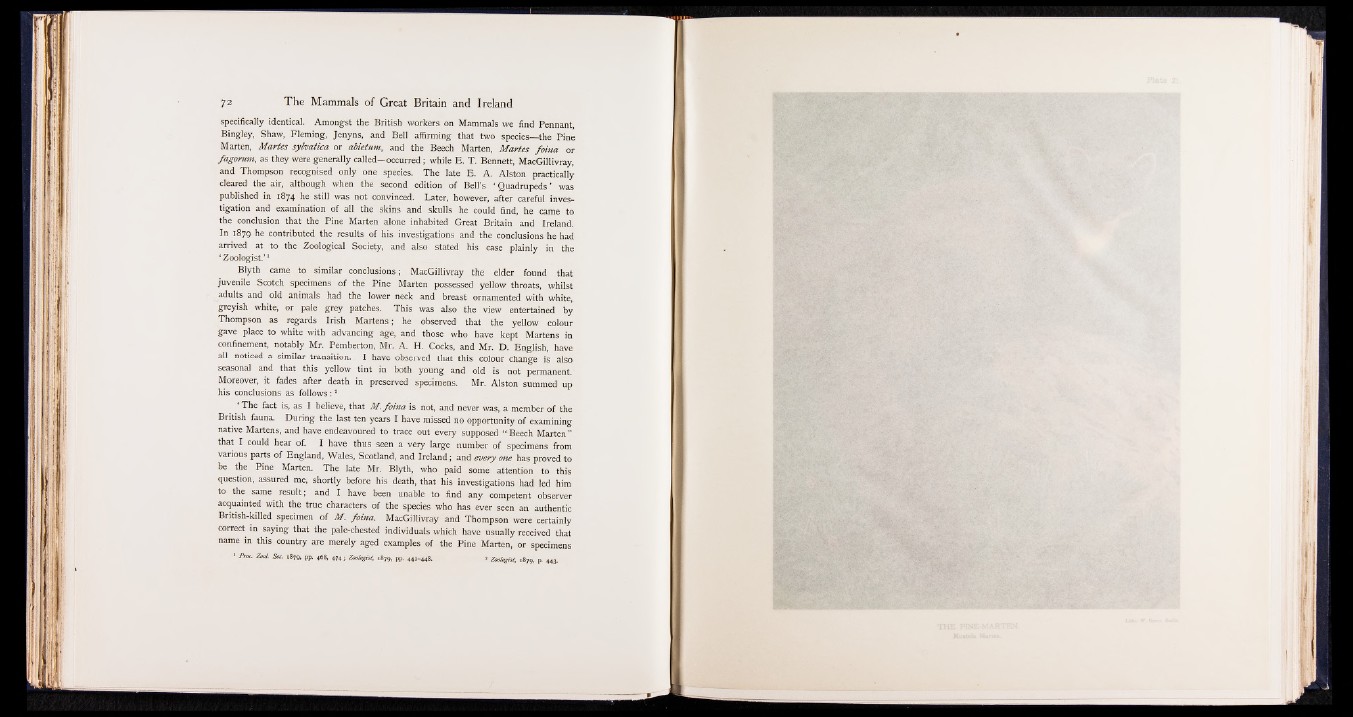
specifically identical. Amongst the British workers on Mammals we find Pennant,
Bingley, Shaw, Fleming, Jenyns, and Bell affirming that two species—the Pine
Marten, M aries sylvatica or abietum, and the Beech Marten, M aries fo itta or
fagorum , as they were generally called—occurred; while E. T. Bennett, MacGillivray,
and Thompson recognised only one species. The late E. A. Alston practically
cleared the air, although when the second edition of Bell’s ‘ Quadrupeds’ was
published in 1874 he still was not convinced. Later, however, after careful investigation
and examination of all the skins and skulls he could find, he came to
the conclusion that the Pine Marten alone inhabited Great Britain and Ireland.
In 1879 he contributed the results of his investigations and the conclusions he had
arrived at to the Zoological Society, and also stated his case plainly in the
‘ Zoologist.’ 1
Blyth came to similar conclusions; MacGillivray the elder found that
juvenile Scotch specimens of the Pine Marten possessed yellow throats, whilst
adults and old animals had the lower neck and breast ornamented with white,
greyish white, or pale grey patches. This was also the view entertained by
Thompson as regards Irish Martens; he observed that the yellow colour
gave place to white with advancing age, and those who have kept Martens in
confinement, notably Mr. Pemberton, Mr. A. H. Cocks, and Mr. D. English, have
all noticed a similar transition. I have observed that this colour change is also
seasonal and that this yellow tint in both young and old is not permanent.'
Moreover, it fades after death in preserved specimens. Mr. Alston summed up
his conclusions as follows: 8
‘ The fact is, as I believe, that M .fo in a is not, and never was, a member of the
British fauna. During the last ten years I have missed no opportunity of examining
native Martens, and have endeavoured to trace out every supposed “ Beech Marten ”
that I could hear of. I have thus seen a very large number of specimens from
various parts of England, Wales, Scotland, and Ireland; and every one has proved to
be the Pine Marten. The late Mr. Blyth, who paid some attention to this
question, assured me, shortly before his death, that his investigations had led him
to the same result; and I have been unable to find any competent observer
acquainted with the true characters of the species who has ever seen an authentic
British-killed specimen of M . fo in a . MacGillivray and Thompson were certainly
correct in saying that the pale-chested individuals which have usually received that
name in this country are merely aged examples of the Pine Marten, or specimens
1 Pnc. Zool. Soc. 1879, pp. 468, 474; Zoologist, >879, PP> 44>-448- ■ Zoologist, 1879, p. 443.